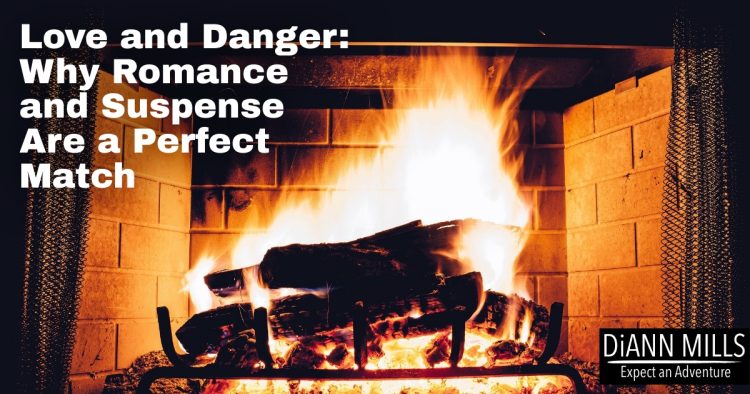By DiAnn Mills @DiAnn Mills
Love and danger have caught the reader’s attention since the beginning of time. Storytellers gathered faithful listeners around a crackling fire and told stories that caused others to tremble with danger and swoon with romance. The match seems perfect, but why does it work?
The following parts of a novel show why love and danger are popular features in our fiction. The romance and suspense have equal billing. That’s a necessity for the romantic suspense genre.
Characters
Romantic suspense always has a hero and a heroine. The reader sees two balanced characters who have traits that show both are strong individuals. They are not equal but complement each other with their unique skills, wisdom, knowledge, expertise, strong values, and experience. The hero and heroine share the goal of stopping an antagonist, be it a person, nature, mental, or an alien encounter. The heroine does not need the hero as her knight in shining armor. Neither does the hero need the heroine as his knightess in glittery robes.
Emotion
The hero and heroine are passionate about ending the crisis. Their emotions are initially for those who will suffer if the antagonist is successful. The two are courageous and willing to take risks that most of us fear. The seven universal emotions are repeated throughout the story: surprise, fear, anger, sadness, disgust, happiness, and contempt.
The respect the two have for each other will escalate to friendship and more by the end of the story. This is the romance aspect, which brings the writer to the next point.
Danger
The hero and heroine experience various types of danger throughout the story. The danger is psychological (unique to the character’s personality and life experiences), professional (again this can be unique to the character), and physical.
Emotions play a critical role in danger:
- If the hero and heroine verbally confess their growing attraction, their work ethics can be compromised. Each could be guilty of putting the case/plot or themselves in danger by reacting unwisely to a dangerous situation.
- Feelings of endearment must be constrained until the big crisis is over. Sometimes they creep through, and that’s all a part of showing humanity.
Plot
The storyline contains missing details in the way of information, the antagonist, the outcome if the antagonist isn’t stopped, and continuous threats. The writer creates emotional tension, stress, and conflict in the reader’s mind, causing concern and worry. Much is at stake if the hero and heroine fail.
Dialogue
Dialogue must always create tension between the characters, even between those who usually agree or are family or friends. Dialogue is filled with double meaning or subtext. *Think of your mother claiming, “What you are not saying speaks louder than what you are saying.”
Considerations include the emotional tension in the romantic relationships and the dialogue with other protagonists or antagonists. What is said. What is not said. What the characters know about each other. Is a character seeking information, to manipulate, betray, or explain?
That brings us to word choice.
Word Choice
Word choice is a powerhouse for the romantic suspense writer. Personality, emotion, genre, plot, and romance weave into a tapestry of who the character is talking to and the motivation for the conversation or internal dialogue.
If the narrative or dialogue is focused on a romantic setting for the hero or heroine, the word choice is flowery, musical, using soft consonants and long vowels. Open body language and kind gazes are part of the word choice.
If the conversation is blunt, suspenseful, or threatening, the word choice uses hard consonants. Short sentences. Stiffened posture. Closed body language and gestures to go with it.
Always emotion and always body language and motivation.
Point of View
Point of view is a treasure chest for the romantic suspense novel. The scene is written in the point of view of whoever has the most to lose and the most to gain in the scene.
Another aspect of point of view is the character’s faith or morals. How does the character view romance and suspense?
Setting
I believe every scene should have an antagonistic setting—an underlying opposition to whatever is the character’s goal in the scene. This works wonderfully in the romance and plot.
The next time you read or write a romantic suspense, think about the traits of the genre that make love and danger a perfect match.
What do you look for in a romantic suspense novel?



Comments 14
Romance and suspense have always been a good combination. Add the Christian element, and it’s a winning combination.
Author
Tim, I agree! In the Bible’s true stories, suspense, love, and God’s intended path for people’s lives are interwoven.
I like the way you put the twists in your novels, DiAnn. It keeps me turning the pages, and I enjoy trying to figure out the puzzle.
Barbara, thank you your kind words. I try to do those things!
This is one of my very favorite genres. I really enjoy the ones where there’s a surprise I didn’t see coming but pulls everything together in the end.
Author
Gail, thank you! We enjoy the surprise element, the twist in plot and unexpected love.
I like the twist of fate and a shocker – when is your next novel coming out
Author
Thanks, Louise! I love those too. I have a Christmas novelette – Snowflakes and Second Chances – https://diannmills.com/books/snowflakes-second-chances/ – available for preorder. My next full length romantic suspense is Canyon of Deceit, and that novel is a September 2025 release.
Thanks!
I love the idea of an antagonistic setting! Thanks, DiAnn.
Author
Tammy, you are welcome! It’s a fun literary technique.
Great article, DiAnn. I like to see two main characters who are attracted to each other romantically, but also understand each other at a deeper level than their attraction. That complexity may lead to a strong friendship or a more fraught relationship. Either way, it gives the story added depth.
Author
Kay, thank you for your insight. I agree!
Romance and suspense. My favorite romantic suspense this year so far was Secondary Target by Angela Carlisle
Author
Thank you for the book recommendation!